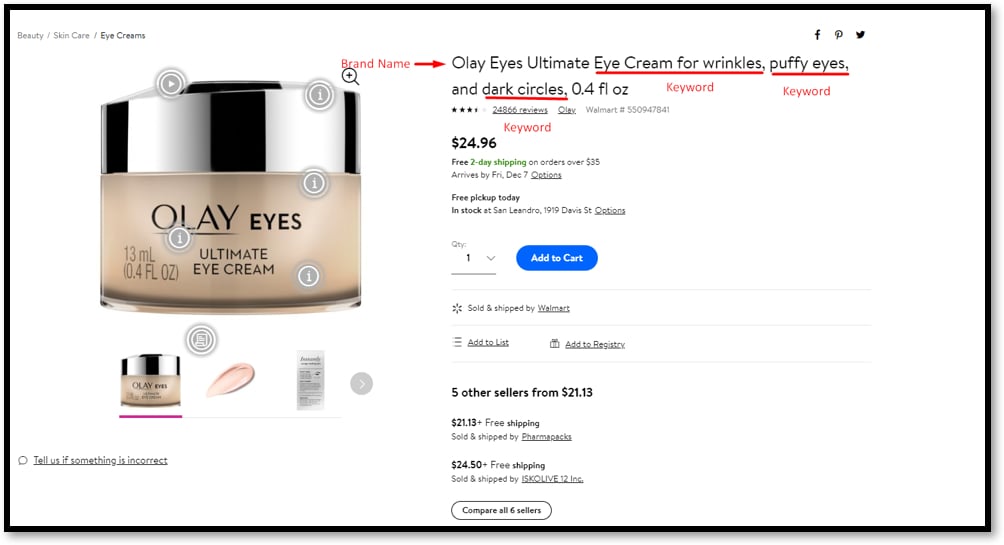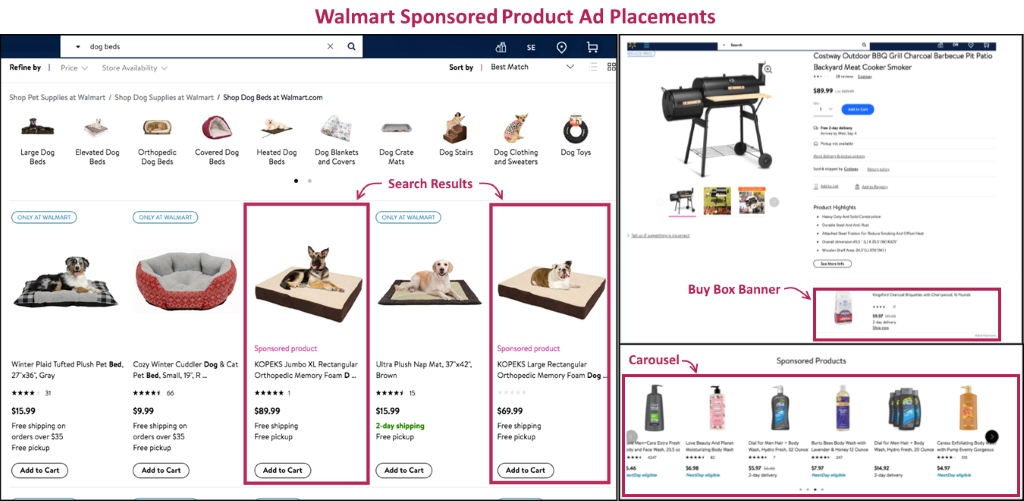The Walmart.com Keyword Research Guide You Need
Most, if not all, of the major online marketplaces, have their own algorithms. These are to determine which products should rank on top while what other items will go beneath them, based on the search term or keyword users enter. There is even Walmart.com keyword research to look into, as Walmart has its own set of rules.
That’s where the power of SEO (search engine optimization) comes in. Being a huge online marketplace, you are vying for the top rank with hundreds of under sellers offering similar products. However, only one will get to win that spot due to the algorithm.
The question is: HOW? There is no exact answer to this, as online marketplaces like Walmart won’t reveal how they operate. Otherwise, everyone will follow the same practices and there won’t be any ‘competition’.
But by being familiar with Walmart SEO and its set of rules, you can increase the chances of scoring that top rank, getting the views and purchases you want. Read on to learn all about Walmart.com keyword research and how to utilize SEO to reach goals!
What is Walmart.com Keyword Research?
Walmart.com keyword research is a crucial part to appease the requirements of Walmart’s search engine. If you want to rank better, you need to make sure that your product listings have appropriate keywords that are used strategically.
Keyword research will help you determine what your keywords need to be, which would be based on the product and the filters. To further understand how Walmart.com keywords work, head to Walmart.com and search for the keyword’ dollhouse’, using all filters.
Use the filters and narrow down your selection, and you’ll further see how the product listings are diminishing a few products. Through keywords and filters, customers can find the exact product they want and need. If you ignore keyword research and don’t give enough details that correspond to the desired product, customers won’t end up seeing your listing on the online marketplace.
This has you lose sales, which is definitely NOT your goal when selling on Walmart.com!
What is Keyword Optimization?
Similar to keyword research, keyword optimization is a kind of SEO, which involves targeting specific keywords people use when finding products. As you go through the article, you will learn more about researching and targeting keywords for your Walmart listings.
Before that, you need to further understand the types of keywords to target. There are two main kinds of keywords, which are:
Short-tail keywords are short and broad search phrases, like ‘men shirt’
Long-tail keywords are longer and more specific search phrases, like ‘black men short-sleeved shirt’
Short tail keywords are required for people to identify your products in a way that both algorithms and shoppers understand. That said, short-tail keywords are broad, making them very competitive with other sellers targeting the same keywords. This is why you need to use long-tail keywords as well.
Long-tail keywords are easier to rank for since they are specific, also generating high-quality traffic that will most likely click and convert. This will then improve your search ranking.
How Walmart.com Keyword Research Helps You as a Walmart Seller
Conducting Walmart.com keyword research before you create and publish your product listings is crucial. Doing so will help you create a description with all the appropriate information to encourage users to purchase from you. Furthermore, you will be able to rank higher and be more visible from your target market, thus increasing the chances of more sales and revenue.
Here are more ways that Walmart.com keyword research helps you as a Walmart seller:
Don’t miss out on money-making keywords
You wouldn’t know if you are using the right keywords in your content unless you conduct research and testing. Never assume you’re aware of what shoppers are searching for and the terms they use most in search engines. You will need to build an effective strategy focused on what people are searching for when finding products similar to yours.
This is done through Walmart.com keyword research. Without keyword research, you end up posting blindly and losing potential sales because you missed important keywords that your target audience is actually typing and searching for!
Identify what your target audience is looking for
Walmart.com keyword research helps you find out what your audiences are searching for, which can help you come up with more ideas on new products and services you might want to roll out in the future.
Furthermore, you can identify long-tail keywords that can help narrow down people’s choices until they find yours, making them more inclined to purchase from you. You will receive more direction on how to get your product listings on top of the search engines, targeting the right audience who will most likely buy your products.
Insights on marketing trends
When you research and analyze keywords, you get more insights into the current marketing trends and consumer behaviors. You are more updated with what’s trending and what your audience finds important at the moment. This will help you know how to describe your product listings and create relevant content that piques shopper interest.
Save time
Without keyword research, you end up spending more time creating content with keywords that don’t rank. Even worse, you end up not using keywords at all, which will have your listings at the bottom rank.
By learning and using the right keywords that rank with your target audience, you have a better return on investment. You also save a lot of time compared to wasting it on keywords that don’t matter.
Discover more opportunities
Keyword research won’t only help you stay relevant while discovering more about your business and product. You also get more opportunities to target traffic to your listings.
From keyword research, you identify keywords and phrases that receive high volumes of traffic, though more expensive and competitive. Don’t let that discourage you, as you can also identify other terms with less competition while still allowing you to gain traffic from them. This helps in creating an effective SEO strategy to attract more traffic and sales.
How to Conduct Walmart.com Keyword Research
Now that you’re more familiar with Walmart.com keyword research and its importance as a seller, the next question is: How can you conduct proper keyword research?
Here are the steps to follow:
Familiarize yourself with keyword terms
There are different types of keywords, representing different levels of intent and interest. They are categorized by type, arranged by their effectivity in terms of conversion.
It’s best to familiarize yourself with these terms and start with those that are more effective in converting. Then, you can move further out. Here are the kinds of keywords to learn about:
Brand terms
Those who know what your brand is will be very easy to convert. When we talk about volume, brand terms may not produce a ton of impressions or page views as expected, but they have the best conversion rate in organic and paid search.
Product terms
These keywords show what your product is about, what it does, and the problems it solves. Depending on your product offerings, this can be a long list. You can get a lot of volume from product terms, especially when you have gotten the most out of brand terms.
Competitor terms
These are the terms your competitor is using, which can be of great help when fighting ranks against strong competitors.
Substitute product terms
This is a term you would use instead of the product. For instance, if you are selling pencils, then you may want to consider bidding or optimizing for the keyword, ‘pencils’.
Complementary product terms
These are terms that would go with your product. For instance, if you are selling TVs, then a complementary product term would be ‘TV stands’. These are another seller’s product terms and while they are different items, you can receive marginal conversions.
Audience terms
This will cover all types of other terms people in the target audience are searching for. The impression volume is quite vast so it’s worth trying.
That said, the category is more aligned with traditional display targeting, based on the audience interest. You may get a lot of recommendations from the higher-ups when trying to use these keywords.
Create a seed list
Seed lists are your initial sets of keyword ideas. Start by writing down the keyword categories I mentioned above, then brainstorm and investigate to fill your list with possible keywords. Spend most of your time on the brand and product terms, which are important when ranking high on Walmart.com.
You will want to be thorough when making this list, but you don’t have to spend most of your time in this step and come up with synonyms and the like. The next steps will help you with this.
Here are tips that can help you create your seed list:
- Research the audience and identify terms that your audience uses when describing your products. Look into the relevant terms they use daily, which you can find from blog posts, comments, forums, social media groups, and even your support requests.
- Find out what search terms are in use right now. You can do this through analytics tools to find out what search terms are used for people to find your product listings.
- You can find suggestions from keyword tools, which have you enter a keyword and shows you a list of potential short-tail and long-tail keywords. There’s no need to run every keyword through these tools, but you can try it out with important keywords to avoid missing out on opportunities.
- Check out what your competitors are doing using competitor analysis tools. This can help you find out what your competitors are ranking for, giving you an idea of what you’re up against and how to be better.
Build a keyword list
Next up, you’ll have to expand your list. You can do this with the help of keyword research tools (or hiring companies with solutions like us here at Analytic Index).
With your chosen keyword research tool, you can group your list of keywords by topic and receive recommendations on what keywords to rank. You will also receive relevant data about these keywords, such as the number of local monthly searches, the competitors who use them, etc.
As you build your keyword list with these tools, you can further filter and narrow down what keywords are relevant based on your audience demographics. Tools would have advanced options and filters to give you keywords that a specific audience uses more.
Once you’re done and have collected all the keywords that are interesting and promising, download it from the tool. You’ll receive it in spreadsheet form for organization and ease of use.
Refine the keyword list
After you have created and built a list of keywords, you’ll need to further refine it until you have the final list of the best keywords. This is crucial for eCommerce SEO, especially because there’s a limit on the number of words you can optimize for reasonably.
There aren’t strict rules in this section, you just need to eliminate the less interesting and engaging keywords. Here are a few factors you can consider when looking for the final keywords to use:
- Keyword category – Concentrate on categories that are closest to your product, dropping less engaging audience terms and focusing more on product keywords.
- Competition – Competitor analysis and keyword research tools show you how much more competition you have over valued keywords. You’ll find out which keywords give you more of a chance of ranking high. While you can focus on less competitive keywords, you may want to go after competitive ones as well.
- Search Landscape – Enter the important keywords on Walmart.com’s search engine and find out the results. You might get a mix of different products! If you have marginal terms of ambiguous meanings, then you may want to drop that keyword from the list.
- Semantic groups – When going through words, group your keywords semantically, dropping those with lower search counts.
Bonus Tips to Conduct Keyword Research
There is more to do when it comes to Walmart.com keyword research. Here are a few bonus tips you can follow to reap its full benefits:
Understand the importance of keywords and topics
Keyword research will help you understand the relevant terms that are associated with your products. When you include a diverse selection of relevant keywords and phrases, it will increase your listing’s rank. It will also help enhance your listing’s content, boosting your rankings.
When you perform keyword research, focus on one primary phrase your product listing and branch out from there. Furthermore, keyword research allows learning more about your products and your business’ niches, including the ones you may not know about yet. Keyword research will provide you keywords that you can include in your listings and content from your business website!
This is why you need to not only understand how important keywords are but know what they entail. Also, learn about your business’ industry and product offerings more, which has you craft engaging content and a well-informed listing that will have people purchase from you.
Know your customers’ language
Regardless of how much of an expert you are in your industry and products, if it won’t match the customer language, then you won’t rank well. This is where keyword research comes along, providing insight that you can’t always get just by interacting with customers or from market research.
Conduct keyword research with your target audience and customers in mind, which gives you an idea of what they want to know and how they search for products. Be aware of the language and the way user intent would change based on the keyword phrase as you research.
Get in the searcher’s head
This is similar to the tip mentioned above about learning your customer’s language. But expand that and focus on other searchers as well. To increase the page views of your product listings, you need to know how to target all of the potential customers.
One way to do this is to know what goes on in searchers’ heads, which is done through keyword research. Understand which keywords match the stages of a buyer’s journey and what they are most likely looking for in certain products, so you can customize your product listing that’s relevant and interesting to customers.
Discover more products and services
When you’re researching for associated keywords for your business, you’ll discover products you can add to it when you plan to grow and expand. While you may not have plans to grow the business right now, at least you will have an idea of ways you can expand in the future, not just focusing on today.
For instance, you are conducting keyword research for your product listings on television sets. Then, you see that there are people who are also searching for television stands or smart boxes for television. With this information, you may want to consider adding those products to your offerings in the near future for more sales and customers.
Competitor research
When you use the right tools for Walmart.com keyword research, you will also get a gist of what other competitors are doing. Some tools offer a feature where you input a website and it gives you a list of keywords and phrase matches, along with their search volumes. This will give you an idea of whether or not you should place these keywords in your product listing or focus on other keywords to rank high.
This helps expand your keyword and SEO strategy, saving you time and money. While you can go after competitor keywords, you can also go after keywords that competitors don’t use but have promised with your target audience, which lessens your expenses.
Develop even better metrics
As you are creating your digital marketing and SEO strategies, you need to know what to expect. By doing this, you are creating realistic goals and parameters, knowing how to analyze the metrics.
Keyword research will give you more of an understanding of the keywords’ efficacy, along with the competition. Through this, you can keep your expectations realistic and know whether or not your strategies are working.
Also, when you can track the keywords you’re targeting, you can identify other keyword trends you can take advantage of. Use your metrics and make sure to monitor the performance of keywords and your strategies to know which ones are working and to continue using them in similar product listings.
Boost your click-through rates
Keyword and SEO research helps you improve your metrics. The research will help you discover more leads, which can have you create relevant product listings and connect with your customers better.
With the right keywords, you can improve traffic and increase the listing’s rank on Walmart.com. And when customers will land on the relevant product listings from the keywords used, your bounce rate will decrease. The keywords won’t only help with your rankings but also match with customer language, which increases the likelihood of them visiting your product listing (over your competitors) to take action.
Make sure that you conduct accurate keyword research so you can boost your click-through rate from Walmart’s search engines.
With all this information about keyword research in mind, remember that this is only one of the many steps to take if you want to optimize your product listings. To receive complete reports about your sales, shopper trends, targeted keywords, and more, you can utilize Analytic Index’s services and see how it can increase your sales and revenue in the long run.
Wrapping It Up
Keywords are a major part of online marketplaces like Walmart.com. They are found in product titles, descriptions, attributes, as well as the images and videos, as a way to help shoppers find your listings. With the right Walmart.com keyword research, you will be able to know what keywords you should use to capture your audience’s attention, thus receiving more sales.
Hopefully, you learned a lot about Walmart.com keyword research thanks to this informative guide. Keep these tips and steps in mind as you conduct keyword research and reap the benefits it has to offer now. Good luck!
If you would like to delve deeper into analytics and receive detailed reports about your sales intelligence and keywords used in Walmart, Analytic Index can help you out. Contact us now and find out how we can help your eCommerce business grow with our ever-growing solutions.





